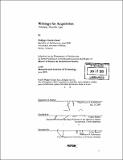| dc.contributor.advisor | Nasser Rabbat. | en_US |
| dc.contributor.author | Saad, Philippe Charles | en_US |
| dc.contributor.other | Massachusetts Institute of Technology. Dept. of Architecture. | en_US |
| dc.date.accessioned | 2006-06-19T17:34:24Z | |
| dc.date.available | 2006-06-19T17:34:24Z | |
| dc.date.copyright | 2005 | en_US |
| dc.date.issued | 2005 | en_US |
| dc.identifier.uri | http://hdl.handle.net/1721.1/33033 | |
| dc.description | Thesis (S.M.)--Massachusetts Institute of Technology, Dept. of Architecture, 2005. | en_US |
| dc.description | Includes bibliographical references (p. 83-87). | en_US |
| dc.description.abstract | This research work started with the exploration of E.M. Forster's major publication on Alexandria published in 1922, Alexandria a History and a Guide, considered until now 'the Classical Guide for Alexandria;' or ironically 'the guide for Classical Alexandria?' In fact, Forster's version of history recounted a Classical heritage all the while effectively attenuating the importance of eleven centuries of Islamic rule and commercial prosperity. As for contemporary name places, they are merely reference points useful to the modern visitor as a means for imagining the missing ancient city. In so doing, Forster relied on a historical tradition without which his book could neither have been written nor have enjoyed such enormous popularity. My thesis investigates the historiography of Alexandria's literary history from the fifteenth to the eighteenth century, with a particular focus on this last century which gave birth to the tradition of looking at Alexandria with Classical eyes. Having pointed at the tradition of looking at Alexandria through Classical eyes, I explore primary European sources (maps and travelers' descriptions and commercial treaties) describing Alexandria from the fifteenth to the eighteenth centuries to identify the key moment when the western interest for Hellenistic Alexandria emerged and neglected its Christian and Islamic heritage. I first examine in the literature of the fifteenth, sixteenth and seventeenth centuries the prevalence of Alexandria as a major Ottoman port-city actively involved in the trade between the Indian Ocean and the Mediterranean Sea. Second, I reveal that the Christian history of the city was of high value to the European travelers who dealt tangentially with its Hellenistic and Roman remains. | en_US |
| dc.description.abstract | (cont.) I therefore affirm that the abandonment of the walled city of Alexandria after the Ottoman conquest of Egypt in 1517, was neither the result of an economic decline nor the consequence of Ottoman misrule, as it appeared to the European visitors in the seventeenth and eighteenth centuries. With this already acquired knowledge, I argue that the European obsession in Hellenistic Alexandria had its causes outside the geographic boundaries of the city. Indeed, this hinge-period coincides with the rise of a new humanism in Europe in the end of the seventeenth century. It was mirrored in Alexandria through the writings of several travelers and envoys such as Corneille le Brun, Benoit de Maillet, Frederick Lewis Norden and Comte de Volney who from one side, resurrected Hellenistic Alexandria in their writings while from the other, dejected the Arab or Islamic civilization occupying and disfiguring this land of antiquity. However, despite their concern for historical accuracy (achieved through travel and archeology), my analysis points out contradictions that betrayed their attempt to reconstruct solely the Hellenistic and Roman city and assign a decline paradigm for the Ottoman town. Engravings as well as paragraphs in the literature they provide reveal the flourishing commerce Alexandria was exerting with Mediterranean cities of the Ottoman Empire, Europe and North Africa. To further support this argument, I examine two mosque patronages that put Alexandria not only on the trade map, but also on the pilgrimage route to Mecca. | en_US |
| dc.description.abstract | (cont.) Studying the eighteenth-century European scholarship on Alexandria, my thesis concludes that this period of unconsolidated knowledge and messy discourse in Europe paved the way to the linear vision of Alexandrian history adopted unanimously after colonialism and the rise of European empires. My thesis brings to a close that Forster's acclaimed book has not been the product of a single individual of the twentieth century, but rather the culminations of a cultural and political tradition whose roots lie beyond the geographic boundaries of Alexandria. | en_US |
| dc.description.statementofresponsibility | by Philippe Charles Saad. | en_US |
| dc.format.extent | 87 p. | en_US |
| dc.format.extent | 6764626 bytes | |
| dc.format.extent | 6768944 bytes | |
| dc.format.mimetype | application/pdf | |
| dc.format.mimetype | application/pdf | |
| dc.language.iso | eng | en_US |
| dc.publisher | Massachusetts Institute of Technology | en_US |
| dc.rights | M.I.T. theses are protected by copyright. They may be viewed from this source for any purpose, but reproduction or distribution in any format is prohibited without written permission. See provided URL for inquiries about permission. | en_US |
| dc.rights.uri | http://dspace.mit.edu/handle/1721.1/7582 | |
| dc.subject | Architecture. | en_US |
| dc.title | Writings for acquisition : Hellenizing Alexandria, Egypt | en_US |
| dc.type | Thesis | en_US |
| dc.description.degree | S.M. | en_US |
| dc.contributor.department | Massachusetts Institute of Technology. Department of Architecture | |
| dc.identifier.oclc | 62100372 | en_US |
